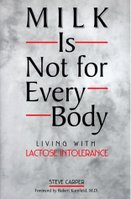Milk-Drinking Crucial to Human Evolution

In my book, Milk Is Not for Every Body, I provided an explanation for lactose persistance, that strange condition which allows adults to drink milk without symptoms. Here's an excerpt from the book:
The combination of the convenient presence of milk from domesticated animals, the nutritional advantage that milk can offer and the genetic dominance of the LP gene form the basis for the current scientific consensus that natural selection pressures account for the astoundingly high percentages of LP in certain corners of the world today. Once set into motion, the spread of milk-drinking appears to be inevitable, having happened at least twice in different ways in different parts of the world.
All that is necessary is that the following three conditions (set out by John D. Johnson, Norman Kretchmer and Frederick J. Simoons in "Lactose Malabsorption: Its Biology and History," Advances in Pediatrics, 1974:21:197-237) be in place. LP is almost certain to appear whenever a cohesive group of people:1) Have a plentiful milk supply;
2) Do not process their milk into products that are low in lactose; and
3) Cannot readily obtain from other available foods essential nutrients that milk does provide.
The situation that would clearly create the greatest selection pressure is the one in which a group has literally nothing else to eat other than milk.
Impossible as it might seem, there are many such groups, all of them tribal nomads on the fringes of the Sahara desert. Take the Beja, who live in the Sudan between the Nile and the Red Sea. As recently as 5,000 years ago, northern Africa had a much wetter climate. When the rains dried up, so did the land, leading to a spread of the desert into traditional nomadic pastoral lands. Agriculture became impossible in this desert setting. Only animals could eat the few plants that naturally grew and no other food sources were available (condition 3). Yet the Beja survive as long as their animals do. During the dry season that may last as long as nine months they live almost entirely on the milk of their camels and goats, up to 3 quarts per adult per day (condition 1). Milk processing and storage in forms that are low in lactose is impossible given the desert temperatures and the nomadic Beja lifestyle. All the milk must be drunk fresh (condition 2). As the Beja clearly satisfy all three conditions, they must have faced enormous selection pressures over the centuries in favor of those tribal members who could drink milk without getting sick. Today, over 80% of the Beja test as LP.
Nor are they alone. Other nomadic desert peoples who have high frequencies of LP include the Bedouins in Arabia and the Libyan desert, Kabbabish in the western Sudan, Tuareg in the central Sahara, and the Fulbe (Peulh) in the northern Sahel. (Whether each is an independent example of LP evolution or whether intertribal mixing of genes occurred is not clear.) Because their particular tribal cultures and unique histories have determined their powerful dependence on milk, this explanation for their LP is known as the "culture historical hypothesis."
None of this exactly qualifies as breaking news. My sources for this are now over 30 years old.
However, everything old is new again, especially when people look at it in a new way.
The genetic mutation which created the lactose tolerance of these African tribes has just now been found, according to Nicholas Wade, in an article in The New York Times, Study Detects Recent Instance of Human Evolution. (May need free registration.)
Intriguingly, the exact mutations for these tribes differ from the one shared by most Europeans. That means it came from a separate set of mutations fostered by separate natural selection, something that is called "convergent evolution." This is one of the first examples of convergent evolution documented at the genetic level.
Wade wrote:
Genetic evidence shows that the mutations conferred an enormous selective advantage on their owners, enabling them to leave almost 10 times as many descendants as people without them. The mutations have created “one of the strongest genetic signatures of natural selection yet reported in humans,” the researchers write.
And it shows the importance to human survival of the domestication of animals and the use of all available natural substances as food.
Far from being unnatural to drink cow's milk, as the anti-milk crowd's propaganda has it, the genius of humans being omnivores appears to be something absolutely basic to humanity's survival.
Try that out at your next PETA meeting.

No comments:
Post a Comment